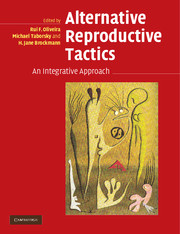Book contents
- Frontmatter
- Contents
- List of contributors
- Preface
- 1 The evolution of alternative reproductive tactics: concepts and questions
- PART I ULTIMATE CAUSES AND ORIGINS OF ALTERNATIVE REPRODUCTIVE TACTICS
- PART II PROXIMATE MECHANISMS OF ALTERNATIVE REPRODUCTIVE TACTICS
- PART III TAXONOMIC REVIEWS OF ALTERNATIVE REPRODUCTIVE TACTICS
- PART IV EMERGING PERSPECTIVES ON ALTERNATIVE REPRODUCTIVE TACTICS
- 16 Communication and the evolution of alternative reproductive tactics
- 17 Alternative mating tactics and mate choice for good genes or good care
- 18 Conflict between the sexes and alternative reproductive tactics within a sex
- 19 Cooperative breeding as an alternative reproductive tactic
- 20 Integrating mechanisms and function: prospects for future research
- Index of species
- Subject index
- References
18 - Conflict between the sexes and alternative reproductive tactics within a sex
Published online by Cambridge University Press: 10 August 2009
- Frontmatter
- Contents
- List of contributors
- Preface
- 1 The evolution of alternative reproductive tactics: concepts and questions
- PART I ULTIMATE CAUSES AND ORIGINS OF ALTERNATIVE REPRODUCTIVE TACTICS
- PART II PROXIMATE MECHANISMS OF ALTERNATIVE REPRODUCTIVE TACTICS
- PART III TAXONOMIC REVIEWS OF ALTERNATIVE REPRODUCTIVE TACTICS
- PART IV EMERGING PERSPECTIVES ON ALTERNATIVE REPRODUCTIVE TACTICS
- 16 Communication and the evolution of alternative reproductive tactics
- 17 Alternative mating tactics and mate choice for good genes or good care
- 18 Conflict between the sexes and alternative reproductive tactics within a sex
- 19 Cooperative breeding as an alternative reproductive tactic
- 20 Integrating mechanisms and function: prospects for future research
- Index of species
- Subject index
- References
Summary
CHAPTER SUMMARY
Many examples of male alternative reproductive strategies have been identified and studied in detail and mechanisms that can allow the maintenance of alternatives have been identified. However, very little research has considered the role of intersexual interactions in the evolution of alternative reproductive tactics (ARTs). In this chapter, I first examine how alternative reproductive tactics within a sex can lead to conflict between the sexes as well as how conflict between the sexes may influence the evolution of alternative reproductive tactics within a sex. I then describe a few empirical examples of species with alternative reproductive tactics where interactions within and between the sexes have been studied. These examples illustrate that a more complete understanding of the evolution and expression of alternatives can be gained by thinking about interactions within and between the sexes concurrently. I also discuss female alternative reproductive tactics and describe a few empirical examples. I then suggest future empirical and theoretical directions needed for a co-evolutionary understanding of the evolution of alternative reproductive behavior patterns in both males and females.
INTRODUCTION
The chapters in this book are a testament to how much we know about the evolution, expression, and diversity of alternative reproductive tactics (ARTs). A number of classic examples of alternatives within a population are now well studied and understood (e.g., Dominey 1980, Gross and Charnov 1980, Gross 1982, Lank and Smith 1987, Shuster 1989, Gross 1991, Shuster and Wade 1991, Lank et al. 1995, Widemo and Owens 1995, Sinervo and Lively 1996, Shuster and Sassaman 1997, Widemo 1998, Sinervo et al. 2000).
- Type
- Chapter
- Information
- Alternative Reproductive TacticsAn Integrative Approach, pp. 435 - 450Publisher: Cambridge University PressPrint publication year: 2008
References
- 22
- Cited by



